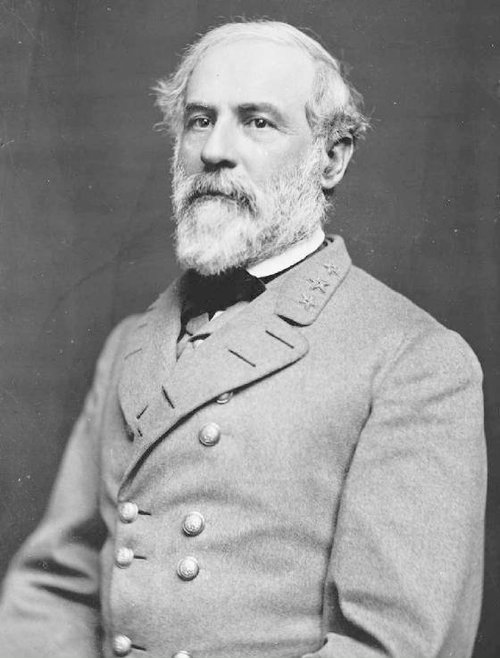


11/05/2017
Adapted from the latest Radio Derb, available exclusively on VDARE.com
So President Trump’s chief of staff, former Marine Corps General John Kelly, praised Confederate General Robert E. Lee on Fox News: "Robert E. Lee was an honorable man. He was a man who gave up his country to fight for his state."
Those are accurate statements, so far as I know. They wouldn’t have been very controversial prior to this summer’s spasm of hysteria over historical statues. They were not very controversial when President Eisenhower had a portrait of General Lee in his White House office. As Ike pointed out when someone grumbled about this, the constitutionality of secession was an open question in 1861.
Lee was not a fan of secession. Once it was a fait accompli, though, he had to choose his loyalty, state or nation. As General Kelly said, he chose his state, and acted with unfailing courage and dignity in defense of that cause.
And defense it was: As Southerners tell you, the Confederates didn’t want to take over the U.S.A; they wanted to get out of it.
And as historian Gene Dattel points out in his new book Reckoning with Race, if toleration of slavery is the touchstone, we had better get busy renaming Washington Square, Madison Avenue, Yale University, the innumerable places and institutions named after Ben Franklin, and so on.
Even some neocons came to the defense of Generals Kelly and Lee — Ralph Peters in the New York Post, for example:
Now we're re-fighting our Civil War with neo-Stalinist, fact-purging propaganda that makes cartoon villains of the dead. We rush to tear down statues of men we refuse to understand. We rob one group of citizens of their heritage to please another …As Colonel Peters implies, we are seeing a deliberate revival of sectionalism, a wilful re-opening of wounds we thought were long healed.Lest I sound like a Southern sympathizer, let me state that my sentiments are pure Yankee. I lost an ancestor who wore blue and recently visited his grave in the National Cemetery in Beaufort, SC.
Kelly Is Right About Robert E. Lee, October 31, 2017
This is not, like mid-nineteenth-century sectionalism, strictly geographical. To be sure, maps of last year’s election results down to the county level show blue oases — mainly coastal and urban — in a sea of red. But the old South, the Confederacy, is not especially red.

This new sectional division is all over. Like the old one, it’s mainly whites against whites, with other races in supporting or auxiliary roles. That’s why I've been calling our current cultural conflict the Cold Civil War. Today’s Johnny Reb, though, is as likely to be a Minnesota machine-tool operator as an Alabama farm boy, as likely to be a computer programmer in New Jersey as a stevedore in New Orleans. The dividing line between the sections is no longer the one drawn by Mr. Mason and Mr Dixon; nowadays that line runs through every state, every town, perhaps every street in the nation.
The passions are as strong as the old sectionalist ones, though. Have you had one of those encounters with a person you didn’t know well, where it somehow emerged that you are a Trump supporter, and the other person flushed angrily, pursed her lips, perhaps said something vituperative, then turned on her heel and stormed off? I had one just the other day.
The awful thing — I don’t think it’s a stretch to say the tragic thing — is that those fomenting this new sectionalism, by for example striving to demonize, or re-demonize, figures like Robert E. Lee, are un-stitching a fabric that was sewn together, very deliberately and painstakingly, by Americans who had actually been through the Civil War.

I’m indebted here to a friend who has just recently lent me a book I did not know about, title The Road to Reunion, 1865-1900 [Ebook] by Paul Buck, published in 1937. It is, simply, the story of that stitching together — as the author says in his introduction, quote: "The history of how two bitter foes were reconciled, two rival societies harmonized."
The aspect of this stitching-together that is I think best known, and which I already knew, was the failure of the movement for treason trials after the Civil War, and the release after two years' imprisonment of Jefferson Davis. His bail was posted by prominent Union figures and abolitionists like Horace Greeley and Cornelius Vanderbilt.
One of the most moving passages in this book concerns the last days of Ulysses S. Grant:
From this point of view [Grant’s desire for peace between the sections], his presidency was a failure, the magnanimity of Appomattox giving way to the excesses of Reconstruction. But in retirement the sturdy qualities of the soldier reappeared. There was something about Grant which suggested indifference to petty quarrels, the bigness of a man who once having fought deplores the indulgence of continued strife. His life closed as did his Memoirs with a fervent prayer for good feeling between the sections. Gradually succumbing to an incurable disease his tranquil and manly fortitude at Mount McGregor won the sympathy of the nation. Throughout his suffering he gave evidence of a hearty and unreserved friendliness toward those who had fought against the Union. The magnanimity of his last words revealed a spirit which went far in composing lingering differences.One of the observers described that spectacle as "the virtual conclusion of sectional animosity in America."He would not have been displeased, therefore, had he been able to witness the union of the sections around his outworn body. The entire country felt the bereavement of his loss. Distinguished Confederate generals wearing gray sashes served as pallbearers with leading officers of the Union army. The spectacle was striking and sincere.
That was in 1885, twenty years after the war’s conclusion. That was the fabric of national unity stitched together so carefully by the Civil War generation.
Now it is being unstitched. That’s the meaning of this renewed hostility to the Confederate flag, to monuments of Lee and Jackson, even to the banning of that fine American book and movie Gone with the Wind.
We are seeing the rise of a new sectionalism, a sundering of what our great-grandfathers so painstakingly put back together.
The agitators who are doing this are driven by a poisonous and fanatical ideology, to which the very idea of a nation is hateful.
Americans who love their country and want to see it carried forward to the future whole and healthy, should resist these agitators with all our might.
John Derbyshire writes an incredible amount on all sorts of subjects for all kinds of outlets. (This no longer includes National Review, whose editors had some kind of tantrum and fired him. ) He is the author of We Are Doomed: Reclaiming Conservative Pessimism and several other books. He has had two books published by VDARE.com com:FROM THE DISSIDENT RIGHT (also available in Kindle) and FROM THE DISSIDENT RIGHT II: ESSAYS 2013.
For years he’s been podcasting at Radio Derb, now available at VDARE.com for no charge.His writings are archived at JohnDerbyshire.com.
Readers who wish to donate (tax deductible) funds specifically earmarked for John Derbyshire’s writings at VDARE.com can do so here.